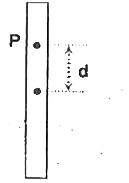Pendulum A is a physical pendulum made from a thin, rigid and uniform rod whose length is d. One end of this rod is attached to the ceiling by a frictionless hinge, so that the rod is free to swing back and forth. Pendulum B is a simple pendulum whose length is also d. Obtain the ratio TATB of their periods for small angle oscillations.
The correct Answer is:A
To find the ratio of the periods of pendulum A (a physical pendulum) and pendulum B (a simple pendulum), we can follow these steps:
Step 1: Determine the period of Pendulum A (Physical Pendulum)
For a physical pendulum, the period TA is given by the formula:
TA=2π√IMgd
where:
- I is the moment of inertia about the point of suspension,
- M is the mass of the pendulum,
- g is the acceleration due to gravity,
- d is the distance from the point of suspension to the center of mass.
For a uniform rod of length d pivoted at one end, the moment of inertia I is:
I=13Md2
The center of mass of the rod is located at d2 from the pivot point. Thus, we can substitute I into the period formula:
TA=2π
⎷13Md2Mgd=2π√d3g
Step 2: Determine the period of Pendulum B (Simple Pendulum)
For a simple pendulum, the period TB is given by the formula:
TB=2π√Lg
where L is the length of the pendulum. In this case, L=d:
TB=2π√dg
Step 3: Calculate the ratio TATB
Now, we can find the ratio of the periods:
TATB=2π√d3g2π√dg
The 2π and √d terms cancel out:
TATB=√13√1=√13=1√3≈0.577
Final Result
Thus, the ratio of the periods of pendulum A to pendulum B is:
TATB=√23≈0.816
For a physical pendulum, the period TA is given by the formula:
- I is the moment of inertia about the point of suspension,
- M is the mass of the pendulum,
- g is the acceleration due to gravity,
- d is the distance from the point of suspension to the center of mass.
⎷13Md2Mgd=2π√d3g
For a simple pendulum, the period TB is given by the formula:
Now, we can find the ratio of the periods:
Thus, the ratio of the periods of pendulum A to pendulum B is:
Similar Questions
A uniform rod of length 1.8 m suspended by an end is made to undergo small oscillations. Find the length of the simple pendulum having the mass and time period equal to that of the rod.
View SolutionTime period of a simple pendulum of length 'L' is T_(1) . Time period of a uniform rod of same length 'L' suspended from one end and oscillating in a vertical plane is T_(2) . Amplitude of oscillation is small in both the cases . Them (T_(1))/(T_(2)) is
View SolutionA pendulum is formed by pivoting a long thin rod of length L and mass m about a point P on the rod which is a distance d above the centre of the rod as shown. The time period of this pendulum when d = L/2 will be
View SolutionA pendulum is formed by pivotting a long thin rod of length L and mass m about a point P on the rod which is a distance d above the centre of the rod as shown.

The time period of this pendulum when d = L/2 will be
View SolutionTime period of a simple pendulum of length 'L' is T1 . Time period of a uniform rod of same length 'L' suspended from one end and oscillating in a vertical plane is T2 . Amplitude of oscillation is small in both the cases . Them T1T2 is
View SolutionPendulum A is a physical pendulum made from a thin, rigid and uniform rod whose length is d . One end of this rod is attached to the ceiling by a frictionless hinge, so that the rod is free to swing back and forth. Pendulum B is a simple pendulum whose length is also d . Obtain the ratio (T_(A))/(T_(B)) of their periods for small angle oscillations.
View SolutionTime period of a simple pendulum of length L is T_(1) and time period of a uniform rod of the same length L pivoted about an end and oscillating in a vertical plane is T_(2) . Amplitude of osciallations in both the cases is small. Then T_(1)/T_(2) is
View SolutionTwo particle of mass m each are fixed to a massless rod of length 2l . The rod is hinged at one end about a smooth hinge and it performs oscillations of small angle in vertical plane. The length of the equivalent simple pendulum is:
View Solution

